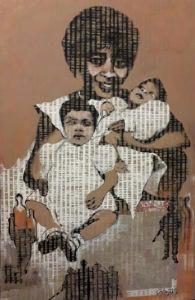

By Prisca Sam-Duru
To commemorate the tragic events of the notorious Asaba Massacre in 1967, an exhibition showcasing a captivating selection of works by Nigerian artists which provoke awareness and recognition of the tragic event in Nigeria’s history, ended last week.
Themed, “Asaba Memorial”, the exhibition aims to inspire remembrance and communal healing through art. It held to support the development of the Asaba Memorial Park – a cultural monument being planned in honour of the victims of the Asaba, Delta State massacre of 1967. A thousand trees will be planted in honour of the 1000 men killed in October 1967 in an open square at Ogbe-Osowa village and separate locations.
The exhibition of relatable art works of the ugly incident opened on Novemebr 27th and ended on December 7, 2022, at the Red Door Gallery, Victoria Island Lagos, as fund raising initiative.
Asaba Memorial is produced by a Whitespace Creative Agency as the first major exhibition to institute a memorial park in honour of the victims of the Asaba massacre of 1967.
The visual narrative on the Asaba massacre, offers a rare insight into the incidence that has long become one of the darkest part of the country’s history. It covers the emotional complexities of a forgotten peaceful community with compelling stories on the trajectory of the horror and the growing realisation of the extent of the massacre during the Nigerian civil war. The exhibition also simultaneously critiques the government and global communities’ inaction to the atrocities that took place and questions commonly held assumptions about the massacre. It further challenges visitors to consider the responsibilities and obstacles faced by those who managed to survive ― from the young widows, women and children to soldiers ― who made difficult choices, to effect change and in a few cases, took significant risks to help victims on that fateful day.
Asaba Memorial features works from over 20 artists, including “In Memoriam”, a monumental canvas piece with the names of some of the victims by a 12-year-old artist – Kanye Okeke, who created the work for the show and, Victor Ehikhamanor’s “Black Peace” (2022), part of the series which was featured as the book cover of Elizabeth Bird and Fraser Ottanelli’s book titled “The Asaba Massacre: Trauma, Memory, and the Nigerian Civil War”.
Also displayed is a body of work donated by Enotie Ogbebor, the son of a senior military officer in the Nigerian army who provided an eye-witness account of the atrocities that occurred in Asaba and renowned fashion designer Ade Bakare’s Ogbueshi – a Guipure cotton lace with red paint and soil that depicts the fate of Chief Mariam Babangida’s father – Late Ogbueshi Leonard Nwanonyei Okogwu, who was to give the welcome address to the soldiers on behalf of the Asaba community on that fateful day.
The group exhibition curated by Otsholeng Poo, and convened by Chief Chuck Nduka-Eze – the Isama Ajie of Asaba, also has Ben Enwonwu’s 1967 painting about the Civil War, “War Dreams” and Bruce Onobrakpeya’s 1972 painting, “Ayo Players”, as part of the collection’s oldest works.
Commenting on the significance of the exhibition, Nduka-Eze explained that the memorial park is designed to illustrate the last journey of the victims, adding that he was a direct victim of the massacre, having lost his mother to the ugly incident.
His words: “The memorial park in Asaba is designed to illustrate the last journey of the victims where they had to go to a public square supposedly to be receiving and welcoming the federal troops.
“Another significant feature of the park is that it’s going to have a thousand trees planted within it. Each tree represents the single live lost. The beauty of that is trees live. And they speak to life, a life lost now lived through trees.”
While pointing out the importance of using art as a powerful catalyst for bringing awareness to important issues that receive only marginal attention, he regretted that “To date, there has been no proper explanation or official apology from the Federal Government of Nigeria for the humanitarian crime. We encourage everyone to come and explore the exhibition. It will challenge people not only to ask, ‘what could have been done?’ but also, ‘what can we do?”
For Nduka-Eze, this is the first step to creating a memorial site that is accessible and dignified in its representation to honour the victims, as well as a place that will be a community symbol of all the lives lost and extend to encompass a cultural and recreational attraction for both local and international tourists.
Interestingly, “The park will have many other features, there is a gallery where a lot of those works will finally find a home. There is also a place where artists can go to further their trade. We have artists residents, also in honour of the collaboration we have with them,” he said.
Curator Otsholeng Poo said, “As a South African who calls Nigeria homehome, I understand the
importance of this exhibition on a very personal level. I am inspired by the people of Asaba’s
continued survival and resounding call for the Massacre to be given its proper place in the
telling of Nigeria’s history. I’m also hopeful that as this project gains supporters from across the continent and the world, we can keep telling the story of Asaba through art and
community. “As the exhibition travels across locations, we intend to invite more artists’ contributions and keep expanding the Park’s collection”.
The post <strong>A thousand memorial trees for Asaba Massacre victims </strong> appeared first on Vanguard News.





